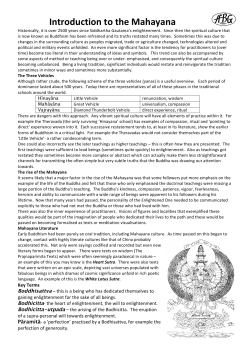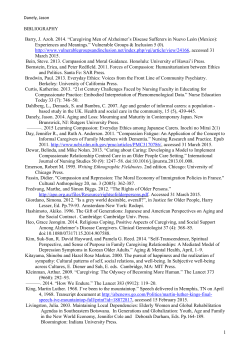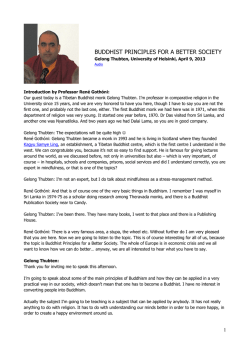
1 Sidney Piburn, ed. The Nobel Peace Prize and
I explore the paradox of compassion, focusing on one sense: that of touch. The compassionate touch—for knowlege, confirmation, healing Intro In his Nobel Peace Prize speech, the Dalai Lama described compassion and love as necessary for feeling “happiness and tranquility and inner strength” (p. 47).1 I was surprised to read his words that “Compassion is based on reason, not just on emotional feeling” (p. 49; it is produced by Nature. It is not a simple entity but rather one that requires “determination and responsibility” (p. 47) to help others overcome suffering. “You cannot destroy it easily as it is very powerful” (p. 48) he reminds. Today I will focus on two Japanese films with stories of women who turn their backs on an active life in the world. In this liminal space we catch a glimpse of divine goddesses at center stage. In particular, I examine two ways the Goddess of Mercy (Avalokitesvara [Sanskrit] /Guanyin [Chinese]/Kannon [Japanese]) comes to life to assist the protagonists. No time to give full plot summaries; happy to talk more at length during the Q and A or afterwards. First written about in the Lotus Sutra, the Bodhisattva of Compassion is at times depicted as female and at other times as male, with a power of transmutation. Theatre scholar David Geoge writes about the “disorienting of gender roles [in the figure of Avalokitesvara] and … the contemplation of the simultaneity of difference and unity, the concurrence of otherness 1 Sidney Piburn, ed. The Nobel Peace Prize and the Dalai Lama (Ithaca, NY: Snow Lion Publications, 1990), 47-49. and togetherness” (21-22).”1 In Japan there are actually seven different representations of the Kannon Bösatsu—one with 11 heads, one with 1, 000 arms (esp. In Esoteric [Vajrayana] Buddhism), there is a seated figure with six arms holding a wish-fulfilling jewel, and so on. However I will refer to the Kannon-sama today as possessing the qualities of a mother-goddess and, following the tradition of Chan/Zen Buddhism, her conflation with Guanyin of the Water Moon (often shown with a giant halo around her head or a bottle of heavenly water). The Book of the Dead (Shisha no sho, 2005 [Voices: Iratsume/Miyazawa Rie, the storyteller/Kuroyanagi Tetsuko, narrated by Kishida Kyōko in one of her last film appearances) Based on the 1974 eponymous novel by Orikuchi Shinobu (1887-1953) which was in turn inspired by the Nō play Taema (attributed to Zeami), Kawamoto´s 70-minute film— his final and longest film before his death in 2005-- uses 138 ningyō (puppets/dolls) and is filmed with a digital camera. Over 400 people worked on this film and contributed funds to it. The stop-motion animation took one year to complete.2 The story is set in the Nara period (710-784 C.E.) when Buddhism was just entering Japan from overseas, and it specifically refers to the historical story of Chūjōhime, a young aristocratic woman who became a nun at age 17. Like Chūjōhime, the protagonist of the film, Lady Iratsume, has become entranced by this new religion of Buddhism. The Noh play features a mae-jite (protagonist in the first scene) of an elderly nun (a manifestation of Amida Buddha) and a nochi-jite (protagonist in the second scene), of the Princess Chūjōhime. The tsure (accompanying character) is a Young girl who is a manifestation of the Bodhisattva of Compassion. This unique film explores the overlap between religious fervor and erotic attraction, exploring the overlap between the Buddha and the wrongly killed Prince Ōtsu in Iratsume’s mind. The Buddha represents Stillness; Prince Ōtsu is a kind of bridge between the secular and the sacred; and Lady Iratsume becomes the embodiment of compassion as she weaves a cloth of lotus leaves to cover the cold shoulders of the apparition of Prince Otsu/the Buddha she has seen in a vision. This weaving by hand is her act of compassion, resulting in the Taema mandala. (Legends states it was woven by Chūjöhime in one night with the help of the Kannon-sama)and shows a representation of the Pure Land, the Western Paradise, full of the souls received by the Amida Buddha (the Buddha of Infinite Light). Mizoguchi film Sanshō dayū (Sansho the Bailiff, 1954), winner of the San Marco Silver Lion prize at the 1954 Venice Film Festival The story of Anju and Zushio, set in the late Heian period of the 11th century, is a resilient one. There was a medieval sekkyo-bushi version by itinerant Buddhist priests, as well as the 1915 rendition in contemporary prose by novelist Mori Ogai 3(1862-1922 In his 1954 film, Mizoguchi used the Mori Ogai version but added the anti-military and overtly humanistic angles to the story. While Ogai stressed the sense of the miraculous in the tale, Mizoguchi (influenced by the postwar liberal climate in Japan) focused more on the harsh realities of this tale of sacrifice and redemption. While Mori Ogai’s story speaks of a statuette of Ojizõ, a protector of children, Mizoguchi chooses Kannon-sama because his film is about adults coming to understand deeper truths. The amulet appears at four key moments in the film (from idealistic father to son Zushio at the beginning, from the deeply compassionate adolescent sister Anju to dying friend Namiji, from Zushio to the members of the royal court as a proof of his true identity, and finally from Zushio to his blinded, abandoned mother after he has renounced his claim to high status). I’d like to just focus on that final scene in which Zushio and his mother are reunited after unimaginable hardship—forced child slavery and branding, forced prostitution and maiming, all forms of humiliation. In this scene (filmed on Kashikojima Island in Mie prefecture), the blinded, maimed mother and her son meet. At first the mother doubts Zushio’s identity and turns away to enter the darkness of the hut, but is convinced by touching the figurine of the Kannon-sama that a distraught Zushio thrusts in her hands. The statuette is here centered in the frame, as her sense of touch reveals an irrefutable truth. but, as the truth of the loss of the father and daughter of the family is revealed, the survivors, Zushio and his mother, turn away from each other, lost in their private grief. The camera makes a sweep up, away from the two huddled figures on the beach and their tragic tale, to encompass a view of the shore where an unnamed man spreads out seaweed to dry. The camera rises to include the ocean sparkling with light, ignoring both the everyday tasks and the monumental tragedy and reunion below. Concluding notes As we have seen compassion becomes a return to one’s full humanity, and an approach to the divine, through a reawakening of the senses. In the practice of Compassion called Tonglen, Tibetan Buddhists learn to breathe in the sufferings of others as grey smoke, and to breathe out a White healing light. In the Book of the Dead, Lady Iratsume absorbs the sufferings of a man,or the Buddha, or both. Chogyan Trungpa Rinpoche reminds that feeling compassion requires (1) egolessness, (2) a sense of emptiness (shunyata), and a sense of communication. The protagonists at the end of these two films display these qualities, guided by a unique sense of touch on a sacred object related to the Boddhisatva of Compassion. 1 David George, “Reorientations: The Sound of Two Hands Clapping…,” in Dis/Orientations: Cultural Praxis in Theatre, Asia, Pacific, Australia. Ed. Rachel Fensham and Peter Eckersall (Australia: Centre for Drama and Theatre Studies, 1999): 21-34. 2 The ¨Making Of¨ documentary (not available on the Kino DVD) shows how the strenuous work for this feature film was divided. There were four rooms: (1) for the dolls, (2) for the filming, (3) for the set construction , and (4) Kawamoto´s own office. The director got to the studio earlier than anyone else to check the colors and the positions of the dolls. 3 There was even a short-lived 1954 stage production adapted by Terrence Malick and directed by the great Polish director André Wajda.
© Copyright 2025















